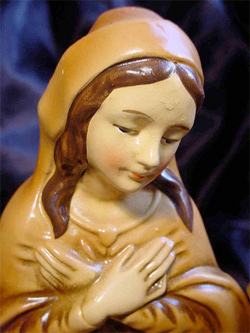When the crowd asks Mary, “Are you a virgin?” she mutters in embarrassment, “None of your business,” and so they nudge one another knowingly: “She is.” On the subject of Christians’ wishful thinking, Monty Python’s Life of Brian isn’t so far from the mark: There is no surviving testimony from the young Jewish woman Mary herself about the ultimate in-vitro fertilization — or anything else, for that matter. Even her name is a matter of confusion: In some gospels she is called Mariám (a version of Miriam) more often than Maria. The details of Mary’s miraculous pregnancy were actually added to the gospels of Matthew and Luke around 80 A.D., some decades after Mary’s death and based on oral traditions that had perhaps blended with fantasy. In fact, the whole virginity business was not considered terribly important for Christians until around 200 A.D., when theologians began to associate physical pleasure with spiritual evil and to promote Mary as the ideal Latin woman — a mother who never had sex. From the start, non-believers had a field day: a scurrilous rumor started in Alexandria that Jesus was really the son of a Roman centurion called Pantherus; others said that Mary had conceived the boy with her own brother, a scandal that her family had to hush up.
Over the centuries, Church theologians had their work cut out for them trying to explain the finer details of Mary’s biological adventure to literal-minded congregations. How was the sacred seed implanted? Some suggested that the Archangel Gabriel slipped it through Mary’s ear, others that it entered through her mouth via the Holy Spirit. The unknown artist who sculpted a 1430 relief in a Würzburg, Germany chapel showed God blowing his semen down from Heaven through a long tube. And how did the Blessed Mother remain a virgin after giving birth? The baby Jesus must have floated magically from the womb, scholars reasoned; according to one colorful story, when Mary’s midwife Salomé doubted this fact and tried to give Mary an exploratory probe, her sacrilegious finger was withered by a divine fire. By the way, whatever happened to Jesus’ siblings? The gospels mention on several occasions that he had brothers and sisters. But these other children, theologians argued, must have been Joseph’s by an earlier marriage.
By the Renaissance, the Mary story was really getting complicated. Early anatomists believed, despite some fairly obvious evidence to the contrary, that both male and female partners must derive pleasure during intercourse in order for conception to occur; it was thought that, during the woman’s orgasm, the ovaries ejaculated their own seed or “semen” in the coital fluid that would blend with the male’s. Thus in the late 15th century, Church theologian Tomás Sánchez was forced to consider: “Did the Blessed Mary emit semen in the course of Her relations with the Holy Spirit?”
His answer: Basically, it’s none of our business. • 14 December 2009
SOURCE/FURTHER READING: Elizabeth Abbot, History of Celibacy (New York, 1999); Warner, Marina, Alone of All Her Sex: The Myth and the Cult of the Virgin Mary, (New York, 1983); Steinberg, Leo, “’How Shall This Be?’ Reflections on Filippo Lippi’s “Anunciation” in London, Part One,” Artibus et Historiae, vol. 8, 1987, 25-44.




